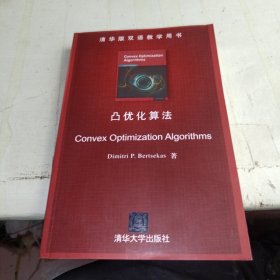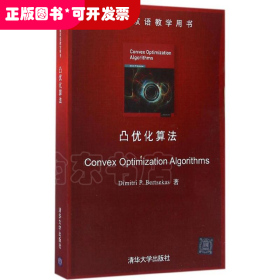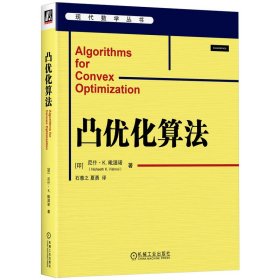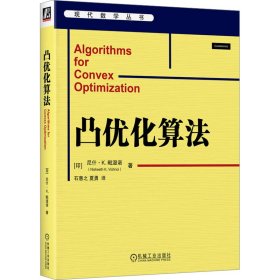
凸优化算法
D2一4
¥ 22 2.5折 ¥ 89 九品
仅1件
北京大兴
认证卖家担保交易快速发货售后保障
作者Dimitri、P.Bertsekas 著
出版社清华大学出版社
出版时间2016-05
版次1
装帧平装
上书时间2024-05-11
- 店主推荐
- 最新上架
商品详情
- 品相描述:九品
图书标准信息
- 作者 Dimitri、P.Bertsekas 著
- 出版社 清华大学出版社
- 出版时间 2016-05
- 版次 1
- ISBN 9787302430704
- 定价 89.00元
- 装帧 平装
- 开本 16开
- 纸张 胶版纸
- 页数 564页
- 字数 623千字
- 正文语种 简体中文
- 丛书 清华版双语教学用书
- 【内容简介】
-
《凸优化算法》几乎囊括了所有主流的凸优化算法。包括梯度法、次梯度法、多面体逼近法、邻近法和内点法等。
这些方法通常依赖于代价函数和约束条件的凸性(而不一定依赖于其可微性),并与对偶性有着直接或问接的联系。作者针对具体问题的特定结构,给出了大量的例题,来充分展示算法的应用。各章的内容如下:第一章,凸优化模型概述;第2章,优化算法概述;第3章,次梯度算法;第4章,多面体逼近算法;第5章,邻近算法;第6章,其他算法问题。《凸优化算法》的一个特色是在强调问题之间的对偶性的同时,也十分重视建立在共轭概念上的算法之间的对偶性,这常常能为选择合适的算法实现方式提供新的灵感和计算上的便利。
《凸优化算法》均取材于作者过去15年在美国麻省理工学院的凸优化方面课堂教学的内容。《凸优化算法》和《凸优化理论》这两《凸优化算法》合起来可以作为一个学期的凸优化课程的教材;《凸优化算法》也可以用作非线性规划课程的补充材料。 - 【作者简介】
- 德梅萃·博塞克斯(DimitriP.Bertsekas),教授是优化理论的国际学者、美国国家工程院院士,现任美国麻省理工学院电气工程与计算机科学系教授,曾在斯坦福大学工程经济系和伊利诺伊大学电气工程系任教,在优化理论、控制工程、通信工程、计算机科学等领域有丰富的科研教学经验,成果丰硕。博塞克斯教授是一位多产作者,著有14本专著和教科书。
- 【目录】
-
1. Convex Optimization Models: An Overview
1.1. Lagrange Duality
1.1.1. Separable Problems - Decomposition
1.1.2. Partitioning
1.2. Fenchel Duality and Conic Programming
1.2.1. Linear Conic Problems
1.2.2. Second Order Cone Programming
1.2.3. Semidefinite Programming
1.3. Additive Cost Problems
1.4. Large Number of Constraints
1.5. Exact Penalty ~nctions
1.6. Notes, Sources, and Exercises
2. Optimization Algorithms: An Overview
2.1. Iterative Descent Algorithms
2.1.1. Differentiable Cost Function Descent - Unconstrained Problems
2.1.2. Constrained Problems - Feasible Direction Methods
2.1.3. Nondifferentiable Problems - Subgradient Methods
2.1.4. Alternative Descent Methods
2.1.5. Incremental Algorithms
2.1.6. Distributed Asynchronous Iterative Algorithms
2.2. Approximation Methods
2.2.1. Polyhedral Approximation
2.2.2. Penalty, Augmented Lagrangian, and Interior Point Methods
2.2.3. Proximal Algorithm, Bundle Methods, and Tikhonov Regularization
2.2.4. Alternating Direction Method of Multipliers
2.2.5. Smoothing of Nondifferentiable Problems
2.3. Notes, Sources, and Exercises
3. Subgradient Methods
3.1. Subgradients of Convex Real-Valued Functions
3.1.1. Characterization of the Subdifferential
3.2. Convergence Analysis of Subgradient Methods
3.3. e-Subgradient Methods
3.3.1. Connection with Incremental Subgradient Methods
3.4. Notes, Sources, and Exercises
4. Polyhedral Approximation Methods
4.1. Outer Linearization Cutting Plane Methods
4.2. Inner Linearization - Simplicial Decomposition
4.3. Duality of Outer and Inner Linearization
4.4. Generalized Polyhedral Approximation
4.5. Generalized Simplicial Decomposition
4.5.1. Differentiable Cost Case
4.5.2. Nondifferentiable Cost and Side Constraints
4.6. Polyhedral Approximation for Conic Programming
4.7. Notes, Sources, and Exercises
5. Proximal Algorithms
5.1. Basic Theory of Proximal Algorithms
5.1.1. Convergence
5.1.2. Rate of Convergence
5.1.3. Gradient Interpretation
5.1.4. Fixed Point Interpretation, Overrelaxation and Generalization
5.2. Dual Proximal Algorithms
5.2.1. Augmented Lagrangian Methods
5.3. Proximal Algorithms with Linearization
5.3.1. Proximal Cutting Plane Methods
5.3.2. Bundle Methods
5.3.3. Proximal Inner Linearization Methods
5.4. Alternating Direction Methods of Multipliers
5.4.1. Applications in Machine Learning
5.4.2. ADMM Applied to Separable Problems
5.5. Notes, Sources, and Exercises
6. Additional Algorithmic Topics
6.1. Gradient Projection Methods
6.2. Gradient Projection with Extrapolation
6.2.1. An Algorithm with Optimal Iteration Complexity
6.2.2. Nondifferentiable Cost Smoothing
6.3. Proximal Gradient Methods
6.4. Incremental Subgradient Proximal Methods
6.4.1. Convergence for Methods with Cyclic Order
6.4.2. Convergence for Methods with Randomized Order
6.4.3. Application in Specially Structured Problems
6.4.4. Incremental Constraint Projection Methods
6.5. Coordinate Descent Methods
6.5.1. Variants of Coordinate Descent
6.5.2. Distributed Asynchronous Coordinate Descent
6.6. Generalized Proximal Methods
6.7. e-Descent and Extended Monotropic Programming
6.7.1. e-Subgradients
6.7.2. e-Descent Method
6.7.3. Extended Monotropic Programming Duality
6.7.4. Special Cases of Strong Duality
6.8. Interior Point Methods
6.8.1. Primal-Dual Methods for Linear Programming
6.8.2. Interior Point Methods for Conic Programming
6.8.3. Central Cutting Plane Methods
6.9. Notes, Sources, and Exercises
Appendix A" Mathematical Background
A.1. Linear Algebra
A.2. Topological Properties
A.3. Derivatives
A.4. Convergence Theorems
Appendix B: Convex Optimization Theory: A Summary
B.1. Basic Concepts of Convex Analysis
B.2. Basic Concepts of Polyhedral Convexity
B.3. Basic Concepts of Convex Optimization
B.4. Geometric Duality Framework
B.5. Duality and Optimization
References
Index
点击展开
点击收起
相关推荐
— 没有更多了 —
























以下为对购买帮助不大的评价